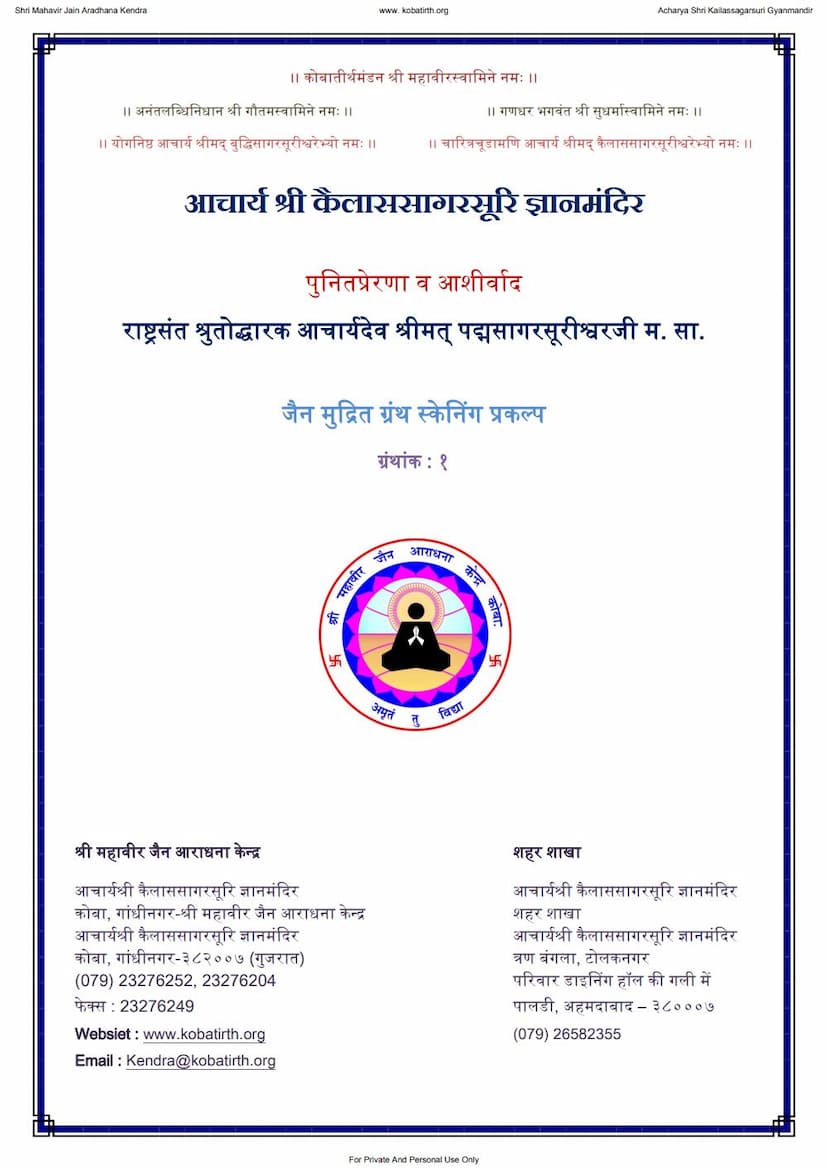Vishva Vibhutio
Added to library: September 2, 2025

Summary
This document is the first "Kiran" (ray) of the "Amar Jain Vachanmala" series, titled "Vishva Vibhutiyo" (Worldly Glories/Great Personalities), authored by Rajhans and published by Amar Jain Vachanmala under the Shri Labdhisurishwar Jain Granthamala. The catalog number is 15.
The book is dedicated to the teachings and inspiration of various Jain Acharyas and Tirthankaras. It specifically focuses on detailing the lives and key attributes of the 24 Tirthankaras of the current era (Avsarpini Kaal) in Bharat Kshetra.
Key Content and Structure:
-
Introduction: The book begins with devotional salutations to Jain spiritual leaders and then introduces the series and its purpose. It emphasizes the importance of Jain literature for imparting knowledge and values to children and young people.
-
The 24 Tirthankaras: The core of the book is a chapter-by-chapter description of each of the 24 Tirthankaras. Each chapter typically includes:
- A Doha (couplet): A concise poetic summary of the Tirthankara's essence.
- Biographical Details: Information about their birth city, parents, lifespan, body height (in Dhanush), distinguishing mark (lanchhan), number of disciples (munis and sadhvis), and the Tirth (sacred place) where they attained Moksha (liberation).
- Key Life Events: Mentions of their significant achievements, such as becoming a Chakravarti (universal emperor) or their unique characteristics.
- Shasan Devtas (Guardian Deities): The Yaksas and Yaksinis associated with each Tirthankara's reign.
- Associated Tirthas: Mention of significant temples or holy sites associated with them.
- Word Meanings (Shabdarth): Definitions of specific Jain terminology used in the chapter.
-
Emphasis on the concept of "Upkar" (Beneficence): The text highlights the profound benefaction of the Tirthankaras in liberating souls from the cycle of birth and death.
-
Chronological Order: The Tirthankaras are presented in their traditional chronological order, from Lord Rishabhdev (Adinath) to Lord Mahavir Swami.
-
Specific Tirthankara Highlights:
- Lord Adinath (Rishabhdev): The first Tirthankara, credited with establishing Dharma and the Chaturvidh Sangh. His son Bharat Chakravarti is mentioned as the composer of the Vedas.
- Lord Ajitnath: His reign saw a longer lifespan.
- Lord Sambhavnath: Mention of his exceptional intention to uplift fellow religious brothers.
- Lord Abhinandan Swami: Described as "Vishva Vibhuti" (worldly glory).
- Lord Sumatinath: His influence in specific Tirthas like Talaja and Matar is noted.
- Lord Padmaprabha: His association with the lotus symbol and his luminous complexion.
- Lord Suparshvanath: Mention of his mark being the Swastik and the fact that his teachings spread throughout India.
- Lord Chandraprabh Swami: His radiant presence compared to the moon.
- Lord Suvidhinath (Pushpadant): Known for his teachings that benefit the world.
- Lord Shitalnath: His teachings are described as cooling and dispelling ignorance.
- Lord Shreyanshnath: He is called the giver of blissful Moksha.
- Lord Vasupujya Swami: Notably, he had a dark complexion, and his Moksha occurred in Champa Puri.
- Lord Vimalnath: His mark is the boar (Varah).
- Lord Anantnath: His mark is the eagle or kite (Sinchan).
- Lord Dharmanath: His mark is the Vajra (thunderbolt).
- Lord Shantinath: He was a Chakravarti and his mark is the deer. His teachings promote peace.
- Lord Kunthunath: His mark is the goat. His body height is noted to be decreasing with time.
- Lord Aranath: Also a Chakravarti, his mark is the Nandavarta (Swastik).
- Lord Mallinath: A significant point is that this Tirthankara was born as a female, which is presented as a remarkable event. Her mark is the pitcher.
- Lord Munisuvrat Swami: His mark is the tortoise. He is described as a ship to cross the ocean of suffering.
- Lord Naminath: His mark is the blue lotus.
- Lord Neminath: A pivotal figure, also known as Arishtanemi. His story of renunciation before his wedding is recounted, emphasizing his celibacy. His mark is the conch shell. His association with Dwarka and Krishna is mentioned. His key disciples include Ambika Devi and Gomeda Yaksha.
- Lord Parshvanath: A highly influential Tirthankara. His mark is the serpent. The story of his encounter with the ascetic Kamatha and the divine protection by Dharanendra and Padmavati is narrated, highlighting his equanimity even when facing hardship (upasarg). Many famous temples are dedicated to him. Mount Shikharji is famously known as Parasnath Hill due to him.
- Lord Mahavir Swami: The last Tirthankara of this era. His birth in Kshatriyakund, parents Siddhartha and Trishala, and his lion mark are mentioned. His lifespan was 72 years, and his death was solitary. His key disciple was Gautam Swami. The text states that the current Jain Shasan (dispensation) is his and will continue for another 18,500 years. The Diwali festival's origin is linked to the lamps lit upon his attainment of Moksha in Pavapuri.
-
Concluding Remarks: The book concludes with a verse stating that by meditating on these 24 Tirthankaras, one can achieve auspiciousness and liberation, with the blessings of Acharya Labdhisurishwar.
-
Advertisement Section: Following the main text, there are advertisements for other publications from the same publisher, including books on palmistry (Shakunavali), children's stories, various Jain Pujas (rituals), and stotras (devotional hymns).
In essence, "Vishva Vibhutiyo" serves as an introductory guide to the lives and significance of the 24 Tirthankaras within Jainism, presented in an accessible and devotional manner for a wider audience, particularly the younger generation.